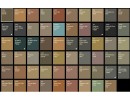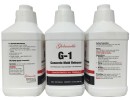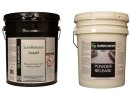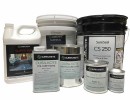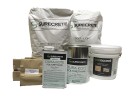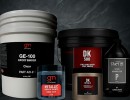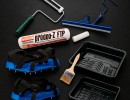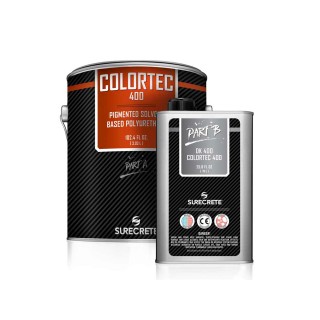
































































- Stock: In Stock
- Model: ColorTec 400
Available Options
ColorTec 400 is a two- component, pigmented, solvent based polyurethane sealer.
The benefit of using solvent based sealers over water-based polyurethanes is additional durability and lower material cost.
In total, the ColorTec 400 has excellent scratch/ abrasion resistance, UV resistance and chemical resistance and is perfect for both commercial and residential applications.
ColorTec 400 can be applied on concrete floors, laboratories, gyms, residential interiors, auto service centers, bars, clubs, retail stores, cafeterias, chemical exposure areas or any high traffic areas where an exceedingly resilient floor is required.
Coverage varies upon substrate, approximately 300-400 square feet per gallon.
Work time / Pot life: 60 minutes.
*Please note that all ColorTec products are mixed to order and are non-returnable and non-refundable.*
| Cure rates @77 F (25 C) | Cure rates @50 F (10 C) |
| Dry to touch: 6-8 hr | Dry to touch: 18+ hr |
| Light traffic: 24 hr | Light traffic: 48 hr |
| Heavy traffic: 3 days | Heavy traffic: 5 days |
| Full cure: 5-7 days | Full cure: 14 days |
Surface Preparation:
Before applying any sealer to concrete, the surface must be prepped to ensure a proper adhesion of topcoat to surface. Missing any parts of the surface prep will most likely result in the sealer flaking off. Ensure you get the most out of our product by following these steps.
- Make sure that the concrete is fully cured. Most concrete is fully cured approximately 28 days after pouring it even though it feels hard to the touch long before this point. To see what happens if this step is not followed you can watch this video.
- Be sure that the concrete is not retaining any moisture. This problem is common in basements and humid environments, and will result in flaking and bubbling under the sealer. To check if your concrete is too moist you can tape all 4 sides of a plastic sheet to the concrete. If there is condensation under the plastic sheet after approximately 16 hours, your concrete is too wet.
- Clean and profile the surface. Contaminates on your surface will prevent the sealer from adhering to your concrete, and sometimes they may cause the sealer to cure improperly. A few examples of common contaminates are dust, dirt, grease, oil, curing agents, paint, efflorescence, glue, rust, algae, and mildew. To clean the concrete, you may grind or shotblast the surface. This will both clean any contaminates off of your surface and also profile it. The pores of the concrete will be opened up and have a much stronger bond with the sealer.
- Patch any small hairline cracks with a product like featherfinish so that they will not be visible after the sealer coating is applied. For larger cracks or uneven floors, we recommend using a self-leveling compound to make the floor as even as possible. Any high points or peaks should be grinded down.
- Any walls that touch your floor should be taped off with painters tape to avoid getting sealer on them.
Planning:
- Product is flammable. Turn off any potential sources of ignition such as fuel burning appliances or pilot lights.
- Provide proper ventilation to prevent the fumes do not accumulate.
- Select appropriate PPE (personal protection equipment). Use of a NIOSH approved respirator is required. Refer to SDS. If you would like to use a product with lower VOC contents, you may consider using ColorTec 400WB.
Mixing:
We recommend setting up a mixing station on unopened trash bags for the easiest clean up. Place it in a location that will not block the progress of your application. Staging is critical so that Part A and part B are not confused with one another or mixed too far in advance.
- Mix the pigmented Part A of the sealer with a jiffy mixer at medium speed or 1 minute to disperse all the pigment properly.
- Pour 1 Part B into 4 Parts A. The kits come premeasured but you may mix smaller amounts by mixing by volume.
- Mix the Part A and B for 2 minutes at a medium speed.
- Set aside the mixer to be cleaned with denatured alcohol at a later time.
Application:
Once A and B are mixed, the catalyzed product should be placed on the floor within 30 minutes. If left in the pail too long, product will cure at an accelerated rate rendering it useless.
- Lay a thin line of ColorTec 400 across the length of your floor.
- Roll it out with a roller designed for sealers. For smaller projects you can use a standard 9-inch roller, but for larger projects we recommend using a larger one. We recommend to “de-fuzz” your roller by rolling it over some blue painters tape.
- The hard-to-reach areas by the corners of your walls can be touched up with a small 6” roller.
- Repeat steps 1-3 until the whole surface is covered. Apply product in an area that can comfortably be covered with the material on a wet roller. Before the roller begins to dry out, become tacky and “pull”. Thin coats are imperative.
- We recommend having a second worker backroll the polyurethane while wearing spike shoes to make sure there are no visible roller marks and that all the material is evenly dispersed on your floor.
- We recommend two coatings of ColorTec 400 as this will greatly increase the strength of the product. If the first coat has cured dry to the touch and is no longer tacky, repeat all steps of application listed above. If first coat has cured beyond 48 hours or if dust or debris has settled into it as it cured, it must be scuffed with a rotational floor machine equipped with a black pad or a 100-grit sanding screen. Follow scuffing or screening with vacuuming. Follow vacuuming with a micro-fiber wipe with a solvent such as xylene, acetone, or denatured alcohol. Proceed with second coat as described above.
Frequently Asked Questions
Q: Can I use only 1 coating of ColorTec 400?
A: Technically yes, however, it is not suggested. For the best results, we highly recommend using two thinly applied coats. That being said, Dura-Kote Colored Polyurethane products have been known to function better than comparable sealers in situations where a single-coat interior floor sealer is required. If you are happy with the color achieved through the first coat of solvent-based colored polyurethane, then the second coat may be substituted with a thin clear coat instead.
Q: Will ColorTec 400 self-level and fill small holes / cracks?
A: To a very slight degree, yes. It is a higher solids content coating than an acrylic sealer, but it does not have a high enough solids content and flowability to fill large voids.
Q: Can ColorTec 400 be used outside?
A: No. Most polyurethanes are designed for interior use only. For exterior applications use an acrylic sealer or ColorTec 400WB (water based). Unlike nearly all polyurethanes, ColorTec 400WB has remarkable properties related to vapor permeability that permit its use in an exterior setting.
Please leave a review
Write Review


